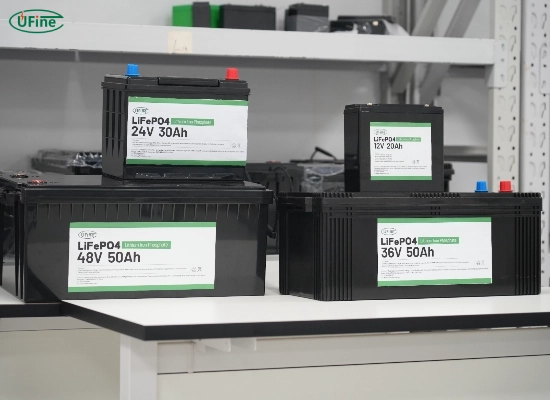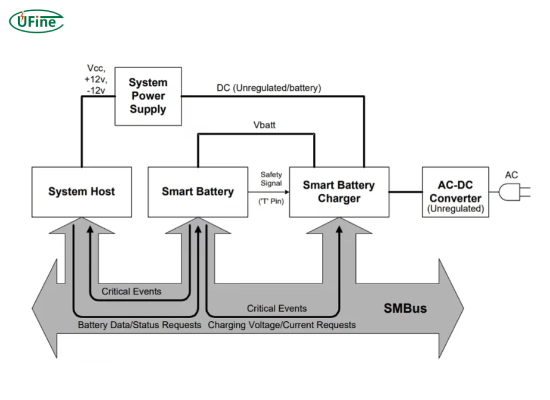In today’s technologically advanced world, batteries are more critical than ever. Batteries are the backbone of modern life, from powering smartphones and laptops to enabling electric vehicles and renewable energy systems. However, traditional batteries have limitations, such as a lack of real-time monitoring and control, which can affect performance and safety. Enter the smart battery—a revolutionary advancement in battery technology that addresses these issues and offers various additional benefits.
Part 1. What is a smart battery?
A smart battery is a rechargeable battery pack with a built-in Battery Management System (BMS). This system allows the battery to monitor and manage its performance, ensuring optimal operation and safety. Smart batteries are commonly used in portable devices such as laptops, smartphones, and other electronic gadgets. They differ from traditional batteries because they have additional terminals for communication with the BMS, including interfaces like SMBus, PMBus, and others.
Critical components of a smart battery
A smart battery consists of several key components:
- Battery Cells: These are the core energy storage units.
- Battery Management System (BMS): This is the brain of the smart battery, responsible for monitoring and managing the battery’s performance.
- Communication Interface: The battery can communicate with external devices and chargers. Standard interfaces include SMBus and PMBus.
Why are smart batteries essential?
Smart batteries offer several advantages over traditional batteries:
- Enhanced Safety: The BMS monitors critical parameters and can prevent overcharging, overheating, and other potentially dangerous conditions.
- Optimized Performance: Smart batteries can extend their lifespan and efficiency by managing charge cycles and usage.
- Real-time Monitoring: Users can get real-time updates on the battery’s status, including charge level and health metrics, which can be crucial for maintaining the performance of high-demand devices.
Part 2. How does a smart battery work?
Smart batteries function through an integrated Battery Management System (BMS), which continuously monitors various parameters such as voltage, current, and temperature. The BMS uses this data to manage the charging and discharging processes, preventing issues like overcharging and overheating. This real-time monitoring and management help extend the battery’s lifespan and improve its performance.
Part 3. Advantages of using smart batteries
Here are some of the key benefits of using smart batteries:
- Longer Lifespan: Smart batteries can manage their charge cycles more effectively, which extends their overall life.
- Improved Safety: The BMS can prevent dangerous conditions like overheating and overcharging.
- Better Performance: Real-time monitoring and management ensure the battery operates optimally.
- Convenience: Users can easily check the battery’s status and health, making it easier to manage and maintain.
Part 4. Applications of smart batteries
Smart batteries are versatile and can be used in various applications, including:
- Consumer electronics: Smartphones, laptops, and tablets benefit from smart batteries’ enhanced performance and safety features.
- Electric vehicles: Smart batteries provide reliable power management, ensuring the safety and efficiency of electric cars.
- Renewable energy systems: Smart batteries enhance the efficiency of solar and wind power storage, making renewable energy more viable.
- Medical devices: Critical medical equipment relies on smart batteries’ reliability and safety features.
Part 5. Smart battery vs. traditional battery
While both smart and traditional batteries serve the same fundamental purpose, they differ significantly in their features and capabilities.
Key Differences
Smart batteries offer more comprehensive monitoring and safety features, making them a superior choice for many applications.
|
Feature |
Smart Battery |
Traditional Battery |
|
Monitoring |
Real-time status updates |
Limited to basic indicators |
|
Safety |
Advanced protection mechanisms |
Basic safety features |
|
Lifespan |
Longer due to optimized cycles |
Shorter due to lack of management |
|
User Interaction |
Detailed information available |
Minimal user feedback |
Part 6. How do smart batteries communicate with chargers?
The communication mechanism between smart batteries and chargers
Smart batteries communicate with chargers through their built-in Battery Management System (BMS). The BMS monitors various battery parameters such as voltage, temperature, and state of charge. It then transmits this information to the charger, which adjusts its charging strategy accordingly to ensure optimal charging conditions.
- Communication protocols
Smart batteries and chargers typically use standardized communication protocols to exchange information. The most common protocols include:
- SMBus (System Management Bus)
SMBus is a widely used protocol allowing two-way communication between the battery and charger. It enables the battery to send detailed information about its current state, remaining capacity, temperature, and other vital parameters to the charger.
- I²C (Inter-Integrated Circuit)
I²C is another popular protocol used for communication between smart batteries and chargers. It’s known for its simplicity and efficiency in data transfer.
Charging control technologies
Smart chargers employ various charging control technologies to optimize the charging process:
- Negative Delta V (NDV) control: The charger detects when the battery voltage decreases and switches from fast charging to trickle charging.
- Time control: The charger stops or switches to trickle charging after a preset charging time.
- Temperature control: The charger adjusts its charging strategy based on changes in battery temperature.
- Maximum voltage control: The charger uses the battery’s maximum allowable voltage to determine the charging state and adjust the process accordingly.
How do smart chargers work?
Smart chargers operate based on the battery type and current state. Here’s a typical workflow:
- Initial detection: The charger first detects the battery type and current state.
- Charging mode selection: Based on the detection results, the system selects an appropriate charging mode (e.g., fast charging, trickle charging).
- Real-time monitoring: During charging, the charger continuously monitors battery parameters and adjusts its strategy accordingly.
- Charge completion: When the battery reaches full charge, the charger stops or switches to trickle charging to prevent overcharging.
Benefits of smart battery-charger communication
The communication between smart batteries and chargers offers several advantages:
- Enhanced safety: Real-time monitoring and adjustment of charging strategies prevent issues like overcharging and overheating.
- Improved efficiency: Optimized charging processes reduce charging time and extend battery life.
- Better user experience: Detailed battery status information allows users to understand their battery battery battery and performance better.
Part 7. How do you choose the correct smart battery?
Choosing the right smart battery can be overwhelming, with so many options available. Here are key factors to help you make the best choice:
Compatibility
Ensure the battery fits your device. Check the voltage and connector type to avoid damaging your device’s performance.
Capacity
The battery’s capacity, measured in ampere-hours (Ah) or milliampere-hours (mAh), shows how much energy it can store. Choose a capacity that meets your device’s power needs. A battery with a too low capacity may last longer, but one with too high a capacity could be bulky and costly.
Voltage
The battery’s voltage must match your device’s requirements. Using the wrong voltage can damage your device. Always verify the voltage specifications before buying.
Size and Weight
Consider the battery’s dimensions and weight. A compact and lightweight battery is ideal for portable devices. Make sure it fits within your device’s compartment.
Maximum Charge and Discharge Current
Check the current ratings for maximum charge and discharge. These affect how fast the battery charges and how much power it delivers. Ensure these ratings meet your device’s needs to avoid slow charging or potential damage.
Cycle Life
Cycle life refers to how many charge and discharge cycles a battery can handle before its capacity drops significantly. A longer cycle life means fewer replacements and better long-term value.
Safety Features
Look for batteries with built-in safety features, such as protection against overcharging, over-discharging, short circuits, and temperature extremes. These features enhance safety and extend battery life.
Brand Reputation
Choose batteries from reputable brands known for quality and reliability. Reading reviews and seeking recommendations can guide you in making an informed choice.
Environmental Impact
Consider the battery’s environmental impact. Opt for batteries made from recyclable materials and those that meet environmental standards. Choosing eco-friendly options helps reduce your carbon footprint.
Part 8. Common misconceptions about smart batteries
Smart batteries have advanced features but often come with misconceptions. Let’s clear up some myths:
- Misconception 1: Smart Batteries Are Too Expensive
Smart batteries may cost more upfront, but their longer lifespan and better performance often lead to savings over time. Fewer replacements and enhanced safety balance result in a higher initial cost.
- Misconception 2: Smart Batteries Are Only for High-Tech Devices
Smart batteries are not just for high-tech gadgets. They’re now common in smartphones, laptops, household appliances, and medical devices, showing their versatility.
- Misconception 3: Smart Batteries Don’t Need Maintenance
Smart batteries need proper care to function well. Regular health checks, avoiding extreme temperatures, and following manufacturer guidelines can extend their lifespan.
- Misconception 4: Off-Brand Chargers Will Damage Smart Batteries
While low-quality chargers can be risky, many reputable off-brand chargers are safe to use with smart batteries. Ensure any charger is compatible and meets safety standards.
- Misconception 5: Smart Batteries Have “Memory” and Need Full Discharge Before Recharging
Modern smart batteries, especially lithium-ion ones, don’t suffer from the “memory effect.” You don’t need to fully discharge them before recharging, as doing so can shorten their lifespan.
Part 9. FAQs
-
What is the main advantage of a smart battery?
The main advantage of a smart battery is its ability to provide real-time monitoring and management, which enhances safety, extends lifespan, and improves overall performance. -
Can smart batteries be used in all devices?
Smart batteries are designed for a wide range of devices. However, before purchasing, it is essential to ensure compatibility with your specific device. -
How do smart batteries improve safety?
Smart batteries improve safety through advanced protection mechanisms like overcharge prevention, temperature monitoring, and short-circuit protection. -
Are smart batteries worth the investment?
Smart batteries are worth the investment due to their extended lifespan, improved performance, and enhanced safety features. -
What is the role of a Battery Management System (BMS) in smart batteries?
The BMS in smart batteries is responsible for monitoring and managing various parameters, optimizing charging cycles, and ensuring the battery’s safety and longevity.
Related Tags:
More Articles

High‑Capacity 3S LiPo Batteries: 5000 mAh vs. 10000 mAh
Compare 3S LiPo 5000mAh vs 10000mAh batteries by weight, power, and use. Find the best fit for your drone, RC car, or boat setup.
Top 5 Applications for Small 3S LiPo Batteries
Small 3S LiPo batteries power drones, RC gear, wearables, and robotics with high energy and low weight. Making them ideal for compact electronics projects.
Building and Charging Your Own 3S LiPo Pack: A Step‑by‑Step Guide
Learn how to build, balance, and charge a 3S LiPo battery pack safely at home with this complete DIY guide for hobbyists and beginners.
How to Choose the Right LiPo Battery Plug Type?
Discover the best LiPo battery plug types, how to choose them, and expert tips for safe usage, soldering, and maintenance.
Choosing the Right Connector for Your 3S LiPo Battery
Choosing the right 3S LiPo connector depends on current, space, and use. Learn the pros and cons of XT60, JST, EC3, and more.






